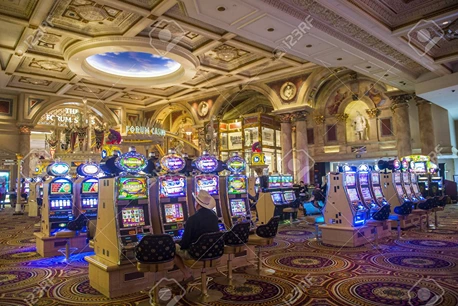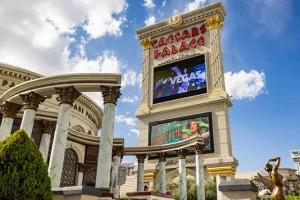Caesars Palace: A Timeless Monument of Las Vegas Grandeur
Nestled on the iconic Las Vegas Strip, Caesars Palace stands as a towering testament to the city’s legacy of excess, elegance, and entertainment, having opened its doors on August 5, 1966. Conceived by visionary entrepreneur Jay Sarno with a $10.6 million loan from the Teamsters Union pension fund, this Roman-themed palace was designed to transport guests into a world of imperial opulence, where every visitor could feel like a Caesar. From its inception, the casino dazzled with a 100-foot chandelier adorned with 100,000 crystals and a staff clad in togas, setting a new standard for luxury gaming resorts. Today, owned by Vici Properties and operated by Caesars Entertainment, it boasts 3,960 rooms across six towers, a sprawling 129,000-square-foot casino, and a reputation as one of the Strip’s most enduring landmarks.
The physical allure of Caesars Palace lies not just in its scale but in its ability to fuse Hollywood-inspired Roman decadence with the thrill of high-stakes gambling. The casino floor, a labyrinth of over 1,300 slot machines and 185 table games, pulses with energy, offering everything from penny slots to $500 pulls for the elite. Beyond gaming, the property’s 300,000 square feet of convention space, the 4,300-seat Colosseum theater, and the lavish Garden of the Gods Pool Oasis—complete with seven pools and swim-up blackjack—elevate it beyond a mere casino into a self-contained empire. Its storied past, marked by celebrity performances from Frank Sinatra to Adele and historic events like the Las Vegas Grand Prix in the 1980s, cements Caesars Palace as a physical icon that continues to define the real-world legend of Las Vegas.
The Heart of a Gambling Empire
The gaming experience at Caesars Palace is a cornerstone of its legendary status, blending tradition with modernity in a way few casinos can rival. The casino’s poker room, recently relocated to a 4,500-square-foot space near The Colosseum, features 16 tables with daily tournaments, while the Caesars Race & Sportsbook dazzles with a 143-foot HD LED screen and 13 betting windows—perfect for sports enthusiasts and horse racing fans alike. Table games like blackjack, roulette, and baccarat cater to a spectrum of players, with limits ranging from modest bets to $15,000 hands for high rollers. This diversity ensures that Caesars Palace remains a playground for all, from casual visitors to seasoned gamblers chasing the rush of a big win.

Beyond the tables and slots, Caesars Palace has mastered the art of spectacle, a trait that keeps it at the forefront of physical casino lore. The Forum Shops, opened in 1992 as one of the first luxury retail experiences tied to a casino, span 675,000 square feet and house over 140 stores, turning shopping into an attraction as potent as the gaming itself. The property’s dining scene, featuring icons like Gordon Ramsay’s Hell’s Kitchen and the Bacchanal Buffet (voted Best Buffet in Las Vegas by USA Today), complements the gambling with world-class culinary offerings. This seamless integration of gaming, entertainment, and indulgence underscores why Caesars Palace remains a living legend, a physical space where every corner tells a story of ambition and excess.
- Casino Size: 129,000 square feet of gaming space.
- Slot Machines: Over 1,300, ranging from penny slots to $500 spins.
- Table Games: 185, including blackjack, craps, and baccarat.
- Entertainment Venue: The Colosseum, seating 4,300 for world-class acts.
- Dining Options: Over 20 restaurants, from Nobu to casual eateries.
Caesars Palace by the Numbers
| Feature | Details | Rating (Out of 5) |
|---|---|---|
| Casino Floor Size | 129,000 sq ft, 1,300+ slots | 4.9 |
| Entertainment Quality | Colosseum with 4,300 seats | 4.8 |
| Dining Variety | 22+ restaurants, award-winning | 4.7 |
| Hotel Capacity | 3,960 rooms across 6 towers | 4.6 |
| Historical Impact | Opened 1966, shaped Vegas culture | 5.0 |
Caesars Palace’s physical presence is a marvel of engineering and ambition, its six towers—Augustus, Centurion, Roman, Palace, Forum, and Nobu—housing nearly 4,000 rooms that cater to a global clientele. The casino floor’s near-perfect rating reflects its vastness and variety, though it occasionally faces criticism for crowded peak times. Entertainment at The Colosseum, hosting legends like Celine Dion and modern stars like Adele, earns high marks, though its focus on residencies limits variety for some tastes. Dining shines with its diversity, though high-end options can strain budgets. Historically, it’s unmatched, having pioneered the lavish casino resort model that defines Las Vegas today.
The property’s ability to evolve keeps it relevant, from its 1970s heyday with Sinatra to its post-2020 recovery after a pandemic closure. Renovations, like the $2.4 million Bacchanal Buffet upgrade in 2021, and expansions, such as the Forum Shops’ 2004 addition, show a commitment to staying ahead of the curve. Its physical infrastructure—marble statues, Roman columns, and the 20-foot Augustus Caesar statue at the entrance—creates an atmosphere of timeless grandeur, drawing millions annually. This adaptability ensures Caesars Palace remains a beacon of real-world casino excellence, a place where history and modernity coexist in harmony.
For high rollers, Caesars Palace offers an elite experience, with private gaming salons and VIP suites like the Marc Antony Villa, featuring whirlpool tubs and Strip views. The Caesars Rewards program, one of the industry’s most popular loyalty schemes, enhances the physical visit with perks like comped stays and dining credits, tying the tangible experience to a sense of exclusivity. This blend of accessibility and luxury makes it a legend not just for its past but for its ongoing relevance, a physical icon that continues to shape the Las Vegas narrative.
- Pools: Seven across five acres, including swim-up blackjack.
- Spa: Qua Baths & Spa, 50,000 sq ft of luxury treatments.
- Retail: Forum Shops with 675,000 sq ft and 140+ stores.
- Nightlife: OMNIA Nightclub, multi-level with a rooftop garden.
- Sportsbook: 143-foot HD screen, 143 seats, and 65 private booths.
Caesars Palace’s legend is as much about its cultural footprint as its physical splendor. It’s hosted everything from Evel Knievel’s failed fountain jump in 1967 (later succeeded by his son Robbie in 1989) to the Formula 1 Las Vegas Grand Prix in 1981-82, raced on its parking lot. The casino has been a backdrop for films, TV shows, and even WrestleMania IX in 1993, cementing its place in pop culture. Its opening night saw guests devour two tons of filet mignon and 50,000 glasses of Champagne, a fitting launch for a venue that’s never shied away from extravagance.
The physical experience of Caesars Palace is visceral—walking through its marble-clad corridors, past replicas of classical statuary, feels like stepping into a Roman fantasy crafted for the modern age. The Colosseum, built for Celine Dion’s groundbreaking residency in 2003, redefined casino entertainment, while the OMNIA Nightclub, with its 75,000-square-foot multi-level design, keeps the party alive into the early hours. These elements, paired with a casino floor that buzzes with anticipation, create a sensory overload that’s uniquely Vegas, a real-world legend that thrives on its ability to captivate.
As Las Vegas evolves, with peers like the Tropicana and Mirage fading into history, Caesars Palace endures, nearing its 60th anniversary in 2026 with the same audacity that defined its birth. Its physicality—acres of gaming, dining, and leisure—offers an escape where every guest is royalty, a promise kept since 1966. Whether you’re rolling dice, sipping cocktails by the pool, or shopping at Gucci, Caesars Palace remains an icon of the real world, a physical casino legend that embodies the spirit of Sin City in every gilded detail.

